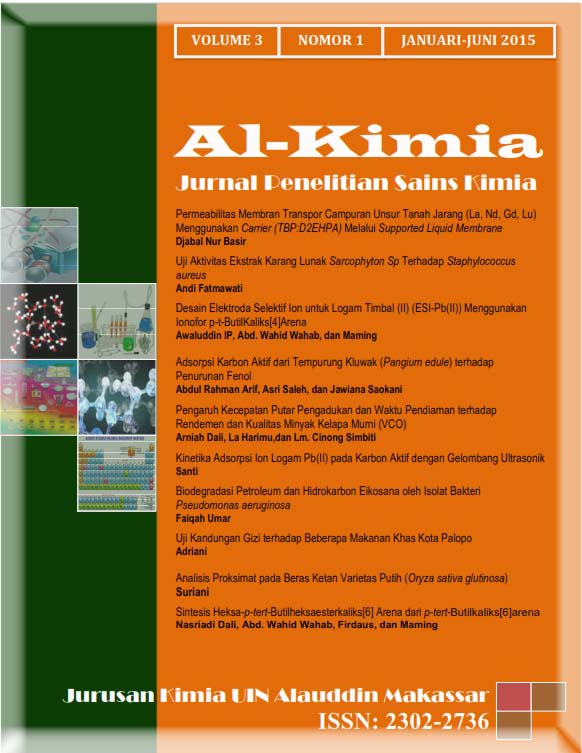Desain Elektroda Selektif Ion Untuk Logam Timbal (II) (ESI-Pb (II)) Menggunakan Ionofor p-t-Butilkaliks [4] Arena
Abstract
This study aims to determine the design pattern ESI-Pb (II) with ionophores pt-butilkaliks [4] arena. In this study, ion selective electrode is designed for the determination of lead (II) (ESI-Pb (II)) using ionophores pt-butilkaliks [4] arenas and diimmobilasi on a matrix of polyvinyl chloride (PVC) in the membrane ESI-Pb (II). The results showed a design pattern ESI-Pb (II) with ionophores pt-butilKaliks [4] arena is best to ESI with membrane composition (% by weight), namely: (pt-butilKaliks [4] arena: KTCPB: DOS: PVC) is 3 : 2: 60: 35 with the Nernst factor: 27.61 mV / decade
Downloads
References
Bailey. P L., 1976, Analysis with ion-selective electrodes, Heyden and Sons, New York.
Buhlmaa, P., Pretsch, E., Bakker, E.,1998. Carier-based Ion Selective Electrodesand Bulk Optodes (2). Ionophoresfor Potentiometric and Optical Sensor, Chem. Review, 98, 1593-1687.
Cunningham, L. 1986. Coated Wire Ion Selective Electrodes. Anal. Chim. Acta. 180, 271–279.
Cha, G. S., Liu, Meyerhoff, M. E., Cantor, H. C., Midgley, A. R., Goldberg, H. D., and Brown, R. B. 1991. Electrochemical Performance, Biocompatibility, and Adhesion of New Polimer Matrices for Solid State Ion Sensors. Anal. Chim. Acta. 63, 1665 – 1672.
Fardiaz,S., 1995. Polusi Air dan Udara, Penerbit Kanisius, Yogyakarta, Heryando, P., 2004. Pencemaran Dan Toksikologi Logam Berat. PT Rineka Cipta. Jakarta.
Gutsche, C.D., 1998, Calixarenes Revisited, Monograph in Supramolecular Chemistry, Royal Society of Chemistry, Cambridge.
Wahab, A. W. 2006. Studi Kinerja Sensor Potensiometrik: Elektroda Selektif Ion Zn(II), Cd(II), dan Hg(II) dengan Ionofor DBDA 18C6 Terhadap Analisis Pencemaran Sedimen Laut Kawasan Pesisir Pantai Makassar. Disertasi. Program Pascasarjana Universitas Hasanuddin, Makassar.
Zolotov, Y, A., 1997, Macrocyclic Compound in Analytical Chemistry, John Wiley & Sons, Inc., New York, 143,229,306,309.
Authors who publish with this journal agree to the following terms:
1) Authors retain copyright and grant the journal right of first publication with the work simultaneously licensed under a Creative Commons Attribution License that allows others to share the work with an acknowledgement of the work's authorship and initial publication in this journal.
2) Authors are able to enter into separate, additional contractual arrangements for the non-exclusive distribution of the journal's published version of the work (e.g., post it to an institutional repository or publish it in a book), with an acknowledgement of its initial publication in this journal.
3)Authors are permitted and encouraged to post their work online (e.g., in institutional repositories or on their website) prior to and during the submission process, as it can lead to productive exchanges, as well as earlier and greater citation of published work (See The Effect of Open Access).


